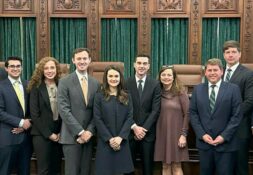A review of the new President’s first month in office
Joseph R. Biden has been President of the United States for little over a month, sworn in on January 20 after a tumultuous transition period from the Trump administration. The November 3 election, held under trying circumstances due to the ongoing COVID-19 pandemic, was fraught with accusations of voter fraud and other inconsistencies from the Trump campaign, which were vehemently denied by the vast majority of state elections officials, including many Republicans such as Georgia Secretary of State Brad Raffensberger. Georgia, a traditionally Republican state, swung for Biden by a margin of approximately 12,000 votes. Trump and some elements of the GOP latched on to the slow ballot-counting processes in key states like Pennsylvania and Nevada as evidence of foul play, though the many lawsuits brought by the Trump campaign all failed to change any result.
The controversy over the election reached a fever pitch on January 6, the day Congress certifies and officially counts the Electoral College votes submitted by the states. A large group of Trump supporters, in Washington, D.C. to attend a speech by the then-President challenging the election results, stormed the Capitol building, forcing the building to be evacuated and placed under lockdown.
In the weeks that followed, massive security measures were implemented to ensure that Biden’s inauguration did not see the same kind of violence. President Trump was impeached for a second time in the waning days of his term for his role in allegedly inciting the riot and challenging his followers to reject the election results. Despite seven Republicans voting “guilty,” Trump was acquitted by the Senate in a 57-43 vote on February 13. The former president has kept a low profile since leaving office, keeping to his Florida residence and meeting only with a few aides and GOP leaders as he reportedly seeks to maintain his hold on the Republican Party and re-enter politics.
In his inaugural address, Biden sought to unify a nation locked in an “uncivil war that pits red against blue, rural versus urban, conservative versus liberal.” Speaking to “all Americans,” he pledged to “fight as hard for those who did not support me as for those who did.” Immediately after taking office, Biden reversed many of the signature executive actions of his predecessor. POLITICO reports that out of the seventeen day-one orders signed by the new President, twelve directly reversed one made by President Trump. Among the most notable actions were a mask mandate on federal property, an order to rejoin the Paris Climate Accord, a revocation of the permit for the Keystone XL pipeline project, and an order halting construction of President Trump’s signature wall on the U.S.-Mexico border. According to a FiveThirtyEight analysis of polls, most of the measures have been quite popular among Americans, but it remains to be seen if such enthusiasm will last as they are implemented in the coming months.
In the weeks since his inauguration, Biden has been focused mostly on combating COVID-19. From a strict numbers standpoint, it would appear that he is doing a far better job than his predecessor. The Center for Disease Control and Prevention’s (CDC) official COVID data shows a steep decline in cases reported, with only 71,214 compared to the all-time high of over 314,000 on January 8.
Of course, it must be noted that the steep decline began during the last days of the Trump presidency, so it is unlikely that the moves made by Biden at the beginning of his term made a significant impact. Rather, the ever-increasing proportion of high-risk populations (specifically the elderly) receiving the COVID vaccine as well as possible coronavirus seasonality is most likely putting downward pressure on the numbers. However, it cannot be denied that Biden’s actions have been popular: an ABC News/Ipsos poll conducted in the first week of February found that two-thirds of Americans approve of Biden’s coronavirus response.
Biden announced a “100 days to 100 million vaccinations” goal early on in his presidency, which is well on track to completion with the nation averaging over 1.7 million shots per day according to the New York Times. Public health officials and Biden himself have cautioned against complacency; as the pandemic certainly is still ongoing and has been responsible for hundreds of thousands of deaths in the U.S. over the past year. It is clear that the near-term success and popularity of the Biden administration will depend on its handling of the virus.
In the long term, however, as the pandemic winds down, Biden’s campaign issues like healthcare, “green jobs,” and other bread-and-butter issues will take center stage. With Democrats holding tenuous control over both chambers of Congress, made possible by a ten-seat majority in the House of Representatives and Vice President Kamala Harris’ tie-breaking vote in the evenly-divided Senate, the new administration will need to tread carefully if they are to retain such control after the 2022 midterm elections, which in recent years often result in the president’s party losing seats.
Implementing his desired policies will be difficult in such a closely divided Congress, as it gives centrists a large amount of power to influence decision making. For instance, West Virginia Senator Joe Manchin, a Democratic moderate, recently announced that he would oppose the confirmation of Neera Tanden, Biden’s nominee to lead the Office of Management and Budget. With Republican moderates Susan Collins of Maine and Mitt Romney of Utah also announcing their opposition, Tanden’s nomination now seems unlikely to be confirmed.
With Biden juggling his slim legislative majority as well as balancing the desire to appease both the establishment and progressive wings of his party, it would have been difficult to govern under normal circumstances. With this past year being anything but, the new President has his work cut out for him.
Luke Koenigsknecht is a sophomore from Grand Rapids, Michigan studying electrical engineering. He can often be found in the Knights of Columbus building. In his spare time, he enjoys reading as well as playing games or solving puzzles. He can be reached at lkoenigs@nd.edu.






Leave a Reply